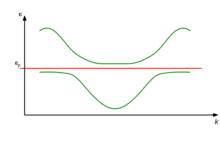


In solid-state physics, Kondo insulators (also referred as Kondo semiconductors and heavy fermion semiconductors) are understood as materials with strongly correlated electrons, that open up a narrow band gap (in the order of 10 meV) at low temperatures with the chemical potential lying in the gap, whereas in heavy fermion materials the chemical potential is located in the conduction band.
The band gap opens up at low temperatures due to hybridization of localized electrons (mostly f-electrons) with conduction electrons, a correlation effect known as the Kondo effect. As a consequence, a transition from metallic behavior to insulating behavior is seen in resistivity measurements. The band gap could be either direct or indirect. Most studied Kondo insulators are FeSi, Ce3Bi4Pt3, SmB6, YbB12, and CeNiSn, although As of 2016[update] there are over a dozen known Kondo insulators.[1]
- ^ Dzero, Maxim; Xia, Jing; Galitski, Victor; Coleman, Piers (2016-03-10). "Topological Kondo Insulators". Annual Review of Condensed Matter Physics. 7 (1): 249–280. arXiv:1506.05635. Bibcode:2016ARCMP...7..249D. doi:10.1146/annurev-conmatphys-031214-014749. ISSN 1947-5454. S2CID 15794370.